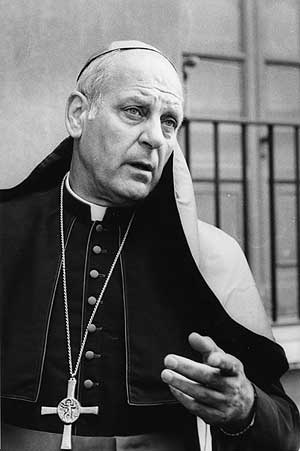Paul Marcinkus facts for kids
Quick facts for kids Paul Marcinkus |
|
|---|---|
| Pro-President Emeritus of the Pontifical Commission for the Vatican City State | |
 |
|
| Church | Roman Catholic Church |
| Appointed | September 26, 1981 |
| Reign ended | October 30, 1990 |
| Predecessor | Sergio Guerri |
| Successor | None; position abolished |
| Orders | |
| Ordination | May 3, 1947 |
| Consecration | January 6, 1969 by Pope Paul VI |
| Personal details | |
| Birth name | Paul Casimir Marcinkus |
| Born | January 15, 1922 Cicero, Illinois, United States |
| Died | February 20, 2006 (aged 84) Sun City, Arizona, United States |
| Previous post |
|
| Alma mater |
|
| Motto | Servite Dominum cum Laetitia |
Paul Casimir Marcinkus (January 15, 1922 – February 20, 2006) was an American archbishop of the Roman Catholic Church. He was also the president of the Institute for the Works of Religion, often called the Vatican Bank, from 1971 to 1989. He received the Grand Cross of the Order of Prince Henry, an important award from Portugal.
Contents
Early Life and Education
Paul Marcinkus was born in Cicero, Illinois, in the United States. His parents were immigrants from Lithuania. He was the youngest of five children in his family. His father worked different jobs, including cleaning windows.
Paul went to Archbishop Quigley Preparatory Seminary and St. Mary of the Lake Seminary. These schools helped him prepare for a life in the church. On May 3, 1947, he became a priest for the Roman Catholic Archdiocese of Chicago. He worked in local churches like St. Christina's and Holy Cross Church. By 1949, he started working for the archdiocese's marriage court. This court handled requests to decide if certain marriages were valid in the church.
Working for the Vatican
In 1950, Marcinkus began special assignments for the Holy See. The Holy See is the government of the Catholic Church, led by the Pope. While studying church law at the Gregorian University, he became friends with Cardinal Giovanni Battista Montini. This cardinal later became Pope Paul VI.
After finishing his degree in 1953, Paul Marcinkus joined a program for future diplomats. He then worked in Bolivia starting in 1955 and in Canada four years later. In both places, he served as a secretary for the Holy See's diplomatic offices.
From December 1959, he worked in Rome at the Vatican's main office. He sometimes helped as an interpreter for Pope John XXIII. He also translated English for Pope Paul VI. Under Pope Paul VI, he helped organize the Pope's trips to other countries. Because he was tall and strong, he sometimes acted as an unofficial bodyguard for Pope Paul VI. This earned him the nickname "The Gorilla." On January 6, 1969, he became an archbishop.
In 1981, Pope John Paul II made Marcinkus an archbishop and a vice-president of the Vatican City State government. This made him like a governor for the Vatican City. In 1982, he was present when a priest attacked Pope John Paul II in Fátima, Portugal. Police officers quickly stopped the attacker and protected the Pope.
Leading the Vatican Bank
Pope Paul VI chose Marcinkus to be a secretary at the Vatican Bank in 1968. In 1971, when he was 48 years old, he became the bank's president. He stayed in this role until 1989. Even though he was good at managing things, Marcinkus did not have much experience as a banker before this job. He received some short training at other banks when he first started.
In the 1970s and 1980s, the Vatican Bank faced some financial problems. Marcinkus was involved in these situations. In 1982, his name came up in news stories about the collapse of a bank called Banco Ambrosiano. Marcinkus had worked with the head of that bank, Roberto Calvi.
The Vatican later paid a large sum of money to help settle these financial issues. Marcinkus once said, "When my workers come to retire, they expect a pension; it's no use my saying to them 'I'll pay you 400 Hail Marys.'" He meant that the church needed money to operate and pay its staff. He left his position at the Vatican Bank on October 30, 1990.
Later Life and Passing
After leaving the Vatican, Marcinkus returned to the Archdiocese of Chicago in 1990. He later retired to Arizona. There, he served as an assistant priest at St. Clement of Rome Church in Sun City. He did not often talk about his time at the Vatican Bank. Archbishop Marcinkus passed away in Sun City, Arizona, at the age of 84.
Honours
- Grand Cross of the Order of Prince Henry, Portugal (September 2, 1983)
See also
 In Spanish: Paul Marcinkus para niños
In Spanish: Paul Marcinkus para niños
- Propaganda Due
- Banco Ambrosiano
- Emanuela Orlandi


